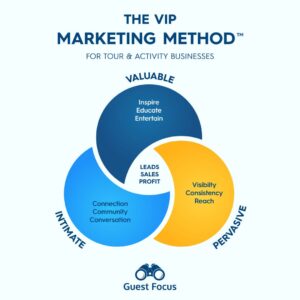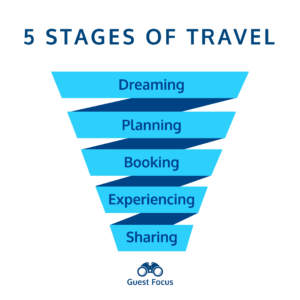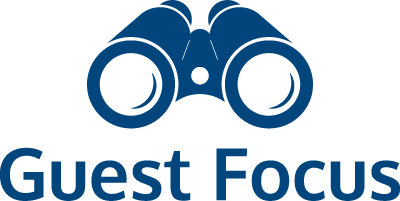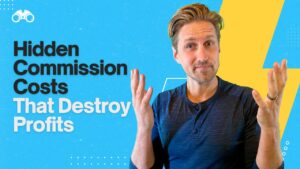Smart Marketing for Tour Operators: Planning, Executing, and Measuring The VIP Marketing Method™
This is the find part in a seven-part series on the VIP Marketing Method™. Watch previous videos here.
The difference between a thriving tour business and one that’s barely scraping by often comes down to one thing: smart marketing. Because while you might be following some of what you’ve learned in earlier videos in this series, you aren’t sure if what you’re doing is making an impact on your business.
How do you know for sure? Measure your results.
Our VIP Marketing Method™ isn’t about creating catchy slogans or pretty logos. It’s about planning, executing, and measuring your marketing efforts to ensure you’re getting a return on your investment.
Let’s look at how you can put together a marketing plan that you can understand, measure, and optimize.
Creating SMART Marketing Objectives
SMART is an acronym that stands for Specific, Measurable, Achievable, Relevant and Time-bound. These criteria ensure that your goals are clear and reachable.
For example, instead of saying “I want more website visitors,” a SMART marketing goal would be “I want to increase my website traffic by 25% in the next six months.”
Here are a few more examples of SMART marketing goals for tour and activity owners:
- Boost email signups by 15% in the next quarter
- Improve booking conversion rate by 5% in the next year
- Increase social media engagement by 30% over the next six months
Remember, your marketing goals should align with your overall business goals. If a business goal is to increase your sales by 20%, then we should have different marketing campaigns with SMART goals that work towards or contribute towards that overall business objective.
Budget Allocation and Resource Planning
At the end of the day, if you’re doing direct marketing, it’s going to take energy to get folks’ attention. That energy either comes in the form of time or money, which can often be an accelerator.
A common method for determining a marketing budget for your direct sales is to simply allocate a percentage of your total revenue. For tour operators in most instances, and as a recommendation in our coaching program, we’re looking at between 5% and 15% of your total revenue to be put towards your marketing budget. This varies depending on your individual goals and stages of growth, but it’s a good guideline.
When it comes to execution of a marketing plan, you’re going to need to balance internal efforts with external help. In any situation, you’re going to have a limited marketing budget, and choosing what to do with it isn’t obvious.
If you’re a small operator just getting started and wondering how to make the most out of limited resources, you’re in luck. Our VIP Marketing Method™ doesn’t require a huge amount of paid ad spend. You can focus on cost-effective strategies like content marketing, email marketing, and social media posting to get things started.
Consider your situation. Are you time-rich but resource-poor? In that case, you might be handling a lot of these marketing tasks in the early days. If you’re time-poor but resource-rich, then we’re going to be looking at tools, hiring external help, whether they’re freelancers or agencies, to help execute on these marketing plans.
If you’re a larger, more established operator with a significant marketing budget, know that our VIP Marketing Method™ can be scaled up rapidly with the addition of paid advertisements. You can add fuel and extra team members to help you repurpose that content, hit as many touch points as you can, and then amplify that reach with paid ad spend.
Tactical Planning and Execution
A basic marketing calendar is a great tool to keep you on track and manage your marketing initiatives. Start by mapping out key dates for your tour and activity business like peak seasons, local events, holidays, etc. Then plan your marketing activities around these dates.
A key part of your tactical planning with our VIP Marketing Method™ is planning out and ultimately creating the seed content – i.e., the written blog posts for each of those stages of travel, from dreaming, planning, booking to experiencing and ultimately sharing.
Once you have your ideas for this written seed content, you’ll need to create it.
The next step is to decide how, where, and when you’re going to repurpose it. Depending on whether you’re just getting started or want to go all the way to advanced, you could be creating email newsletters from that content, repurposing and recording it into video formats, doing short-form videos, infographics, or any number of repurposed ways to get that content on new mediums and new platforms.
In your content calendar, schedule the publication of your seed content first, then in the weeks following, plan out how you’ll publish and promote the repurposed content. The key is to choose channels where your ideal customers spend their time and maintain a consistent presence across those platforms.
Remember, your content calendar can and should be somewhat flexible. As you track performance and gather insights, you may need to adjust your tactics. You may find that some of your repurposed content is performing better than others. You may get new ideas for seed content. All of this is entirely appropriate, and the idea is to have a steady stream of valuable content that helps your potential guests all the way through each stage of that traveler’s journey.
Measuring and Optimizing Results
You can’t improve what you don’t measure. So setting up analytics is crucial. Start by setting up Google Analytics for your website. It’s free and provides valuable insights into your website traffic and user behavior.
Some key performance indicators for tour, activity, and experience businesses often include:
- Website traffic
- Conversion rate (the percentage of visitors who actually book a tour or make a deposit)
- Email opt-ins (either from lead magnets or detailed itineraries downloaded for multi-day operators)
- Average booking value of your shopping cart
- Email open rates or click-through rates
- Social media engagement rates
Typically, for any given marketing SMART goal, there will be one or maybe two key performance indicators or key metrics that we’re keeping an eye on to measure the success of that campaign. It’s typically appropriate to track these metrics in some kind of dashboard where we can see the progress that we’re making towards that goal, our projected progress, as well as the actuals reported week to week or month to month, as is appropriate.
If you’ve got a marketing team or a marketing agency, then they can use this data to make adjustments to the marketing plan. For example, you may notice that a blog post about local cuisine got a lot of engagement, and you might create more content on that topic. If it’s just you and some part-time help doing all the marketing, then you can use this data to make sure that you’re getting the best bang for your buck, or that your effort is getting a return.
Sometimes, tracking marketing data and getting all these numbers and KPIs can feel a little bit overwhelming, but remember, let’s keep things simple. At the end of the day, we’re simply looking for continuous improvement. Regularly review the one or two key metrics that let you know if your marketing is working, and if not, we simply adjust tactics.
So there you have it, a simple, no-nonsense overview of how to have a marketing plan in your tour and activity business. By setting SMART goals, allocating your resources wisely, executing strategically, and measuring your results, you can create a marketing strategy that truly drives your business forward.
Did you miss the first videos in our VIP Marketing Method™ series? Read on!
What is the VIP Marketing Method™?
VIP stands for Valuable, Intimate, and Pervasive. These three elements form the backbone of effective tour marketing:
- Valuable: Provide genuine value to your ideal target guests through entertaining, educational, and inspiring content.
- Intimate: Build trust, rapport, and loyalty by humanizing your brand and creating personal touch points.
- Pervasive: Maintain a consistent multi-channel presence across the places where your ideal guests spend their time and attention.

While each element is powerful on its own, the real impact comes when you implement all three simultaneously across the five stages of travel.
Creating Valuable Content Across the Five Stages of Travel

Let’s take a closer look at how to create valuable content for each stage of the traveler journey:
- Dreaming: Inspire your potential guests with captivating stories and visuals.
- Planning: Educate with practical information, insider tips, or guidance on upcoming travel.
- Booking: Reassure with engaging content about what to expect and clarify how to do business with you.
- Experience: Enhance their trip with real-time valuable information and support.
- Sharing: Encourage and facilitate the sharing of their experiences, turning them into advocates.
Need help? Book a free 45-minute strategy call with us today and start your marketing on the right path!




